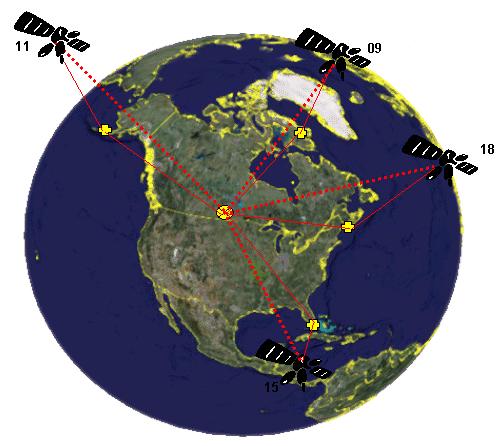
Have you ever wondered what’s going on inside of that GPSr you
own when you turn it on? How does it work? What it is doing is
quite amazing and this cache is all about giving you some
appreciation for the complexity of it all. When you get down to the
challenges involved what is amazing is that it works at all.
Most experienced geocachers know that their GPSr is a radio
receiver, locking on to available signals from a constellation of
24 (+/- a few spare) US Military satellites. The carrier transmits
from the satellites at 1575.42 MHz and within each signal pseudo
random code is embedded at 10.23 MHz. This lower frequency code
gives information about the satellite’s orbits (almanac data),
their clock and orbit corrections and other system status
(ephemeris data). Because the GPSr knows to look for the specific
pseudo random codes of each satellite in the signal it can filter
out a lot of noise and use a very low power signal negating the
need for a big antenna like you would see on other satellite signal
receivers.
So in this puzzle we are receiving signals from 4 satellites and
the signals are travelling in more or less a straight line from the
satellites through the ionosphere, troposphere and other layers of
the atmosphere to the receiver at a little less than the
speed of
light (c = 299,792,458 metres per second).

In simple terms the GPS is a stopwatch that times the
transmission delay from 3 or more satellites to the receiver. By
measuring the lag in the pseudo random code between the signals
received from the satellite and the GPSr clock the GPSr can figure
out how far away the satellites are from the receiver.

But if the timing is off by even one thousandth of a second that
translates into 300 km of error, and since atomic clocks used in
the satellites cost between $50000 and $100000 the GPSr has to use
a clever trick to synchronize it’s clock with GPS time. The GPSr
uses a fourth satellite signal and looks for a single time
correction to the GPSr clock that will allow the distances from all
four satellites to intersect, thereby turning your inexpensive
handheld GPSr into a synchronized clock that is nearly as accurate
as an atomic clock.
In this case the satellite positions and difference in signals
between the receiver and each satellite (SV – Space Vehicle)
are:
|
SV |
Lat |
Long |
Height (m) |
DeltaTime (s) |
|
15 |
24.54653 |
-81.79745 |
20183000 |
0.070808428 |
|
09 |
63.75088 |
-68.56082 |
20183000 |
0.069105305 |
|
11 |
53.90460 |
-166.52657 |
20183000 |
0.073341842 |
|
18 |
43.41038 |
-65.61692 |
20183000 |
0.069680227 |
The height is above the WGS84 ellipsoid. Can you be the GPSr and
calculate the position of the cache and the offset in the GPSr
clock? You can assume that all other factors that mess with the
timing, like multipath signals, atmospheric delays, satellite
timing errors and others have been accounted for already and do not
factor into the equation.
Some wisdom from Dr. Carl Sagan:
“We live in a society exquisitely dependent on science and
technology, in which hardly anyone knows anything about science and
technology.”
“... the use of our intelligence quite properly gives us
pleasure. In this respect the brain is like a muscle. When we think
well, we feel good. Understanding is a kind of ecstasy.”

|
This cache was created to add to the number of QUALITY
caches hidden in Manitoba. It is an official BLITZ cache for the
May Madness event. Hope you enjoy the
hunt! |